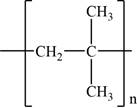
(a)
Interpretation:
The structure of polyisobutylene is to be drawn.
Concept Introduction:
(a)
Answer to Problem 26.21SP
The structure of polyisobutylene is shown in Figure 1.
Explanation of Solution
Polyisobutylene formed from the cationic polymerization of isobutylene which proceeds through the formation of tertiary cation at the carbon containing two methyl groups. Therefore, the structure of polyisobutylene polymer is,

Figure 1: Structure of polyisobutylene.
(b)
Interpretation:
The polymerization of isobutylene is an addition or condensation polymerization is to be stated.
Concept Introduction:
Polymerization is the process of formation of a long chain polymer by the reaction of one or two monomer. The product formed in the polymerization contains the repeated units of the monomer from which it is formed.
(b)
Answer to Problem 26.21SP
The polymerization of isobutylene to form butyl rubber is an addition polymerization.
Explanation of Solution
Addition polymerization is the polymerization in which polymer is formed by the addition of several monomer units to form a long chain polymer. It generally consists of one monomer unit.
Condensation polymerization is the polymerization in which two or more monomers combine to form a larger product along with the loss of water molecules. The resultant product repeatedly combines with another product to form long chain polymer.
The polymerization of isobutylene involves the addition of several monomer units to form a long chain polymer. Therefore, this is an example of addition polymerization.
(c)
Interpretation:
The polymerization of isobutylene would be most appropriate in cationic, anionic or free radical polymerization condition is to be predicted.
Concept Introduction:
Polymerization is the process of formation of a long chain polymer by the reaction of one or two monomer. The product formed in the polymerization contains the repeated units of the monomer from which it is formed.
(c)
Answer to Problem 26.21SP
The polymerization of isobutylene to form butyl rubber proceeds in most appropriate way through cationic polymerization.
Explanation of Solution
The formation of a long chain polymer becomes favorable only due to the stability of intermediate formed in the chain propagating step. Higher is the stability of cation, anion or free radical formed in the polymerization reaction, more favorable will be the polymerization process. In case of isobutylene, one carbon atom contains two electron donating groups which increase electron density on the carbon atom. Therefore, the formation of cation is more favorable in case of isobutylene as it forms tertiary cation and stabilized by two electron donating groups. Thus, the polymerization of isobutylene occurs in the most appropriate way through cationic polymerization.
Want to see more full solutions like this?
Chapter 26 Solutions
Organic Chemistry Plus Masteringchemistry With Pearson Etext, Global Edition
 Chemistry & Chemical ReactivityChemistryISBN:9781133949640Author:John C. Kotz, Paul M. Treichel, John Townsend, David TreichelPublisher:Cengage Learning
Chemistry & Chemical ReactivityChemistryISBN:9781133949640Author:John C. Kotz, Paul M. Treichel, John Townsend, David TreichelPublisher:Cengage Learning Chemistry & Chemical ReactivityChemistryISBN:9781337399074Author:John C. Kotz, Paul M. Treichel, John Townsend, David TreichelPublisher:Cengage Learning
Chemistry & Chemical ReactivityChemistryISBN:9781337399074Author:John C. Kotz, Paul M. Treichel, John Townsend, David TreichelPublisher:Cengage Learning Chemistry: The Molecular ScienceChemistryISBN:9781285199047Author:John W. Moore, Conrad L. StanitskiPublisher:Cengage Learning
Chemistry: The Molecular ScienceChemistryISBN:9781285199047Author:John W. Moore, Conrad L. StanitskiPublisher:Cengage Learning Chemistry: An Atoms First ApproachChemistryISBN:9781305079243Author:Steven S. Zumdahl, Susan A. ZumdahlPublisher:Cengage Learning
Chemistry: An Atoms First ApproachChemistryISBN:9781305079243Author:Steven S. Zumdahl, Susan A. ZumdahlPublisher:Cengage Learning ChemistryChemistryISBN:9781305957404Author:Steven S. Zumdahl, Susan A. Zumdahl, Donald J. DeCostePublisher:Cengage Learning
ChemistryChemistryISBN:9781305957404Author:Steven S. Zumdahl, Susan A. Zumdahl, Donald J. DeCostePublisher:Cengage Learning





